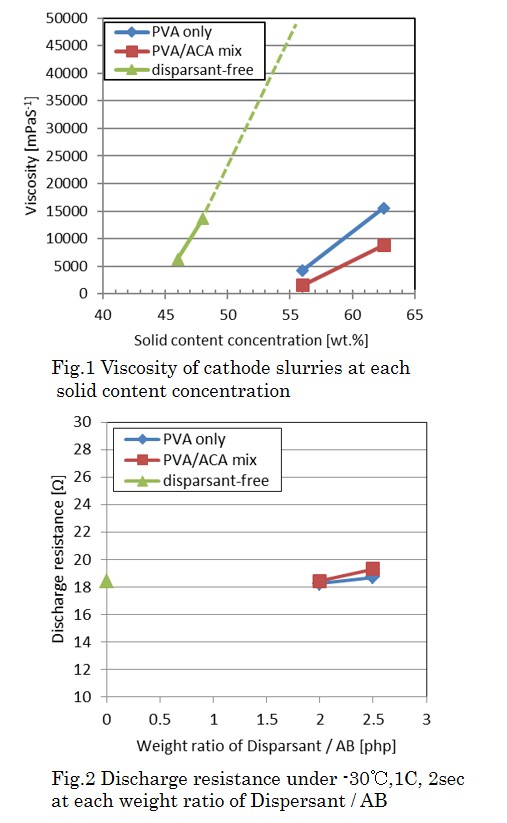Abstract
Generally, cathode of Li-ion batteries was fabricated through the process that cathode slurry composed of active material, conductive agent, binder and N-Methyl-2-pyrrolidone (NMP) as organic solvent was coated on the aluminum foil, dried and pressed. In recent years, decreasing an amount of NMP has been required in terms of low environmental impact and due to cost reduction regarding material, shipping and machining price. However, the decreasing is possible to raise the viscosity of the cathode slurry and cause the defect of manufacturing process such as mixing, carrying and coating.
One of the means of the resolving is addition of dispersant to cathode slurry. The dispersant can make an effect to reduce the slurry viscosity with low amount of solvent because it spreads the distance between each particle and also keep the condition of particle distribution. However, the dispersant may have the potential to be the resistance of the battery reaction because the material is polymer.
In this study, we have designed dispersants that have the low viscosity of the cathode slurry with low amount of NMP, and hardly block the battery reaction by means of clarifying the function of dispersants and optimizing the component.
The cathode slurry was prepared by the following steps: firstly, acetylene black (AB) as conductive agent, polyvinylidene difluoride (PVdF) as binder and dispersants were mixed with NMP. This paste is commonly called 'AB paste'. Secondly as active material was added to the AB paste and mixed. The weight ratio of each material is as follows, active material:AB:PVdF:dispersant=89.8:8:1.5:0, 0.16, 0.20. Three solid content concentrations were considered as 48, 56 and 62.5 wt.% by adjusting the amount of NMP. Two dispersant materials were considered as a polyvinyl alcohol (PVA) with the role adsorbing to AB, and an acrylate copolymer including amid groups (ACA) with the role adsorbing to not only AB and but also active materials. They were composed of polymers not to be resistant according to previous study. And three samples were evaluated such as PVA only, PVA/ACA mix (weight ratio; PVA:ACA=85:15) and dispersant free.
Cathode was prepared through the process coated the slurry on aluminum foil, dried and pressed. The test cells were assembled with the prepared cathode, anode composed of graphite, separator, and electrolyte including LiPF6.
The viscosity of cathode slurry was evaluated under 1S-1 shear rate condition by using Dynamic viscoelasticity measuring device (DMA). And the discharge resistance was evaluated under -30℃, 1C as battery performance.
Fig.1 shows the results of cathode slurry viscosity with various solid content concentrations. The tendency that the viscosity increases with increasing solid content concentration is observed. Especially at the 62.5 wt.%, the viscosity with added dispersant had much lower than dispersant-free. Furthermore, the effect to decrease the viscosity with PVA/ACA mix was higher than that with PVA only and the viscosity with PVA/ACA mix is less than 10000 mPas-1 as the target with no defect in the mass production process. These results imply the repulsive force with not only AB but also active material is required at 62.5 wt.% due to the distance between each particle is shorter under higher solid content concentration.
Fig.2 shows the discharge resistances with various weight ratios of dispersant / AB used by cathode slurry at 62.5 wt.%. The tendency that the discharge resistance with PVA/ACA mix is slightly higher than PVA only is observed. These results imply that ACA with the role adsorbing to active material may affect to the reaction at the surface of active material. However, the resistance with added dispersant at dispersant / AB = 2 php is close to that with dispersant free is appeared. These results may be mainly depended on the effect of dispersant components not to be resistant and less dispersion performance with dispersant free. More detailed and integrated analysis about the dispersant components will be presented and discussed in this work.

Figure 1

